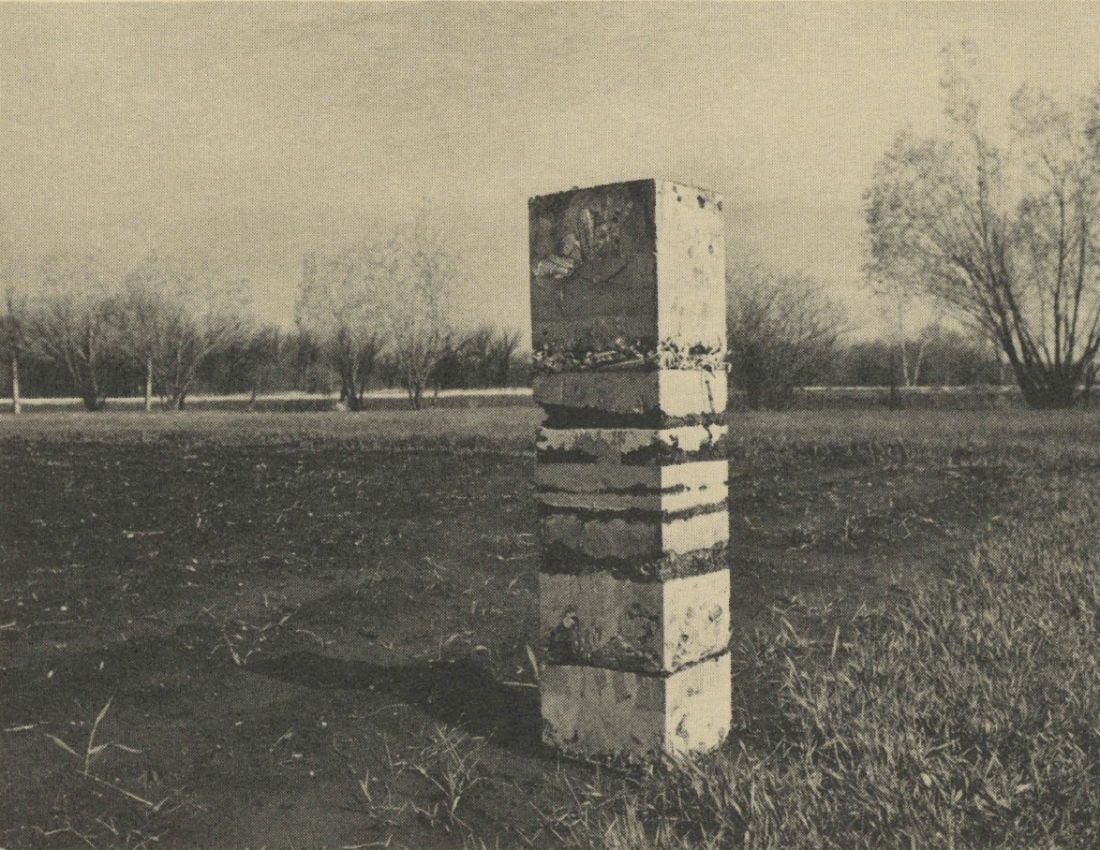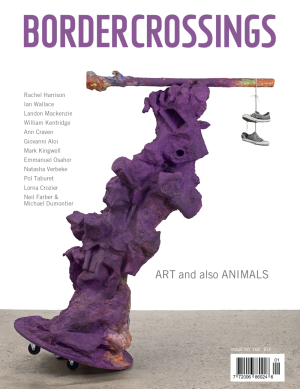Marcel Gosselin: Delta
At the entrance to Delta, Marcel Gosselin’s latest exhibition, hangs a door suspended a little eerily in the air. The book Delta, the literary accompaniment to the sculptural works, also opens with this white door. It is at once an invitation and an obstacle—an invitation because Gosselin wishes to lead his viewers through a spiritual journey, an obstacle because he believes that they must struggle to find its meaning.
Delta is a world where distinctions merge. In Gosselin’s work the lines between inner and outer space, between the man-made and the natural, between death and rebirth, between past and present are blurred and softened. The installation is divided, seemingly, into two parts. But the divider (a line running along the floor and rising to frame a doorway) points only to the futility of imposed boundaries. Is it keeping something in, or something out? Can it really divide the world as clearly as it seems to?
The first half of the installation is an interior; the pieces suggest rough-hewn furniture—tables and shelves perhaps. But this house is overrun by nature. The sleeping table is made of well-constructed, white-painted wood, but the top of the stool is a forest floor—a black square of dirt, leaves, and twigs. The collector is a construction of small shelves and pigeon-holes. It is filled with accumulations of the natural world—feathers, bones, sticks. There is an impression, in these interior pieces, of human works overtaken by time, dust and overgrowth.
On the other side of the boundary humankind encroaches on nature. Earthseed, a sphere composed of pyramids of twigs, is studded with human artifacts—tools, clothes, toys. The pillar is a tightly-compacted tower of leaves, earth and twigs, layered with plaster and shredded newspapers. Here the chaos of nature is moulded into the order of architecture.
In his writing about these pieces Gosselin describes a work called The seeder as a tree that has “grafted upon it human ideas: a string, a paddle, a metal piece”. It looks, he writes, “strangely useful”. For Gosselin, art seems to come out of this merging of the human and the natural. The artist may transform raw nature, but nature also transforms the artist. Art, then, is not product but process, a delicately navigated spiritual journey.

The Pillar, 1986, Marcel Gosselin. Photo courtesy Winnipeg Art Gallery.
In Gosselin’s book, a visitor to Delta remarks that “uncertainty (has) become my companion”. Gosselin relishes this uncertainty and his work is full of “visions and revisions”—drastic and sudden shifts in scale and in viewpoint. The observatory, for example, invites us to observe not outer space, but the infinity of black space inside it. The sleeping table seems to be a piece of stable, useful furniture, but inside it is a small lakeside landscape that suddenly reverses normal, human scale. It’s easy to ask, as Gosselin’s visitor does, “Am I peering down from a hole in the sky?” In The warm handles, dark earthen shapes hang in a window to catch the sun. But the window opens into another room. Again, are we inside or are we outside? Are we looking into a microcosm or out to a macrocosm?
Time, too, is disjointed in these pieces. Some works seem to be archaeological fragments of a long-dead past, others seem to grow before our eyes. Objects are constructed to emphasize the passage of time. In The pillar and The collector, layers of materials become the records of accrued time, the strata of memory.
EarthSafe, a work that is referred to in the book but unfortunately not included in the exhibition, is a moulded earthen shape. In the natural landscape it is nourished by ground moisture, but it is also eroded by wind, rain, and heat. For Gosselin it is a perfect representation of the transient nature of experience:
Its presence is simple. But its life is rich, complex and often incomprehensible. But we can only perceive it after it has disappeared, after its skin has crumbled. When it is gone, another is born of the same mould, but never the same. Like every visitor who comes, it is unique. Like the visitor, it stays but a moment. To my visitor I offer it, for they are so much alike.
Gosselin’s art is not static or stable; his works are in a constant state of flux. His landscapes are at once decaying and fecund; rotting beets irrigate cotton cords, metal trinkets slowly rust on damp canvas, surfaces become slowly covered with dust. In Delta Gosselin offers his viewers not monuments, but what he calls the “residue” of monuments—the image that each visitor takes away with him. In a world of constant change, memory is a necessary ritual.
For Gosselin the physical objects of sculpture do not stand alone. Their creation by the artist and their re-creation by the viewer are equally important. For this reason, the book Delta is an integral part of the exhibition. In part it is a melancholy, poetic tale. Writing from the point of view of the visitor to Delta and of the “man in white”, its creator and spiritual guide, Gosselin hints at his views of nature, of knowledge and of creation. As well, his careful line drawings document the construction of all the pieces, pointing out surprising intricacies and ingenious engineering. This book is not a catalogue; it is, as its editors say, “Livre d’avant les oeuvres. Livre d’après les oeuvres. Livre dans les oeuvres.” The book does not explain the sculptures; the sculptures do not illustrate a story. Taken as a whole, Gosselin’s literary and sculptural Delta is mysterious, difficult but ultimately satisfying. ■
Alison Gillmor is a Winnipeg art critic and a frequent contributor to Border Crossings.

